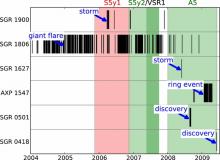
Abstract
Soft gamma repeaters (SGRs) and anomalous X-ray pulsars (AXPs) are thought to be magnetars: neutron stars powered by extreme magnetic fields. These rare objects are characterized by repeated and sometimes spectacular gamma-ray bursts. The burst mechanism might involve crustal fractures and excitation of non-radial modes which would emit gravitational waves (GWs). We present the results of a search for GW bursts from six galactic magnetars that is sensitive to neutron star f-modes, thought to be the most efficient GW emitting oscillatory modes in compact stars. One of them, SGR 0501+4516, is likely ~1 kpc from Earth, an order of magnitude closer than magnetars targeted in previous GW searches. A second, AXP 1E 1547.0–5408, gave a burst with an estimated isotropic energy >1044 erg which is comparable to the giant flares. We find no evidence of GWs associated with a sample of 1279 electromagnetic triggers from six magnetars occurring between 2006 November and 2009 June, in GW data from the LIGO, Virgo, and GEO600 detectors. Our lowest model-dependent GW emission energy upper limits for band- and time-limited white noise bursts in the detector sensitive band, and for f-mode ringdowns (at 1090 Hz), are 3.0 × 1044d 21 erg and 1.4 × 1047d 21 erg, respectively, where  and d 0501 is the distance to SGR 0501+4516. These limits on GW emission from f-modes are an order of magnitude lower than any previous, and approach the range of electromagnetic energies seen in SGR giant flares for the first time.
and d 0501 is the distance to SGR 0501+4516. These limits on GW emission from f-modes are an order of magnitude lower than any previous, and approach the range of electromagnetic energies seen in SGR giant flares for the first time.